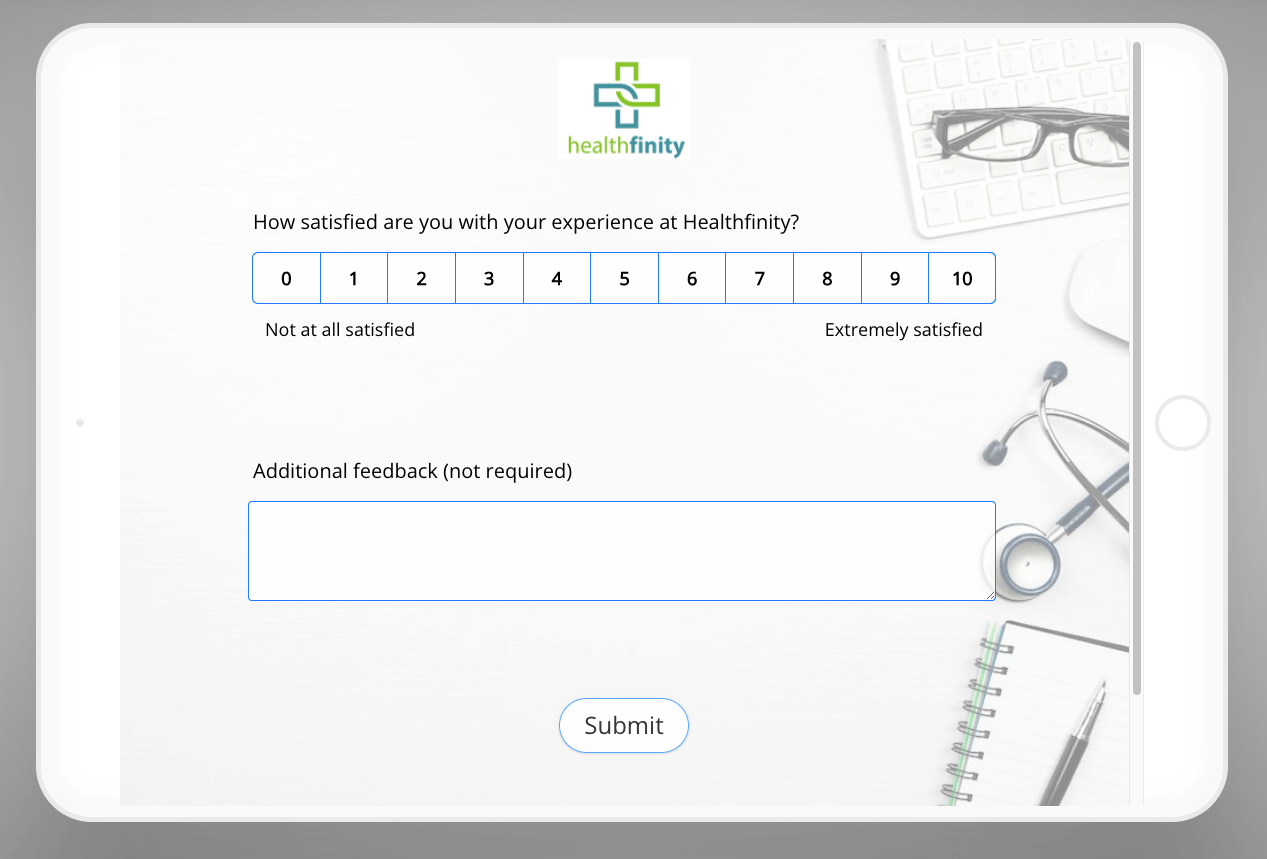Online surveys, when created and used effectively, can be invaluable for the healthcare industry. The use of healthcare surveys is often two-fold. Surveys may be used internally to determine whether staff is engaged, motivated, well-trained, and have the resources they need to perform the duties of their job. They can also be used as patient satisfaction surveys, which are often used as follow ups to give providers insight into whether they are meeting the expectations of their patients or if they are lacking in any area. Unfortunately, response rates for both physician surveys and patient surveys can be lacking. In this blog, we’ll look at how to create an effective healthcare survey with images to improve those response rates.
Create your healthcare survey with images now!
Response Rates for Healthcare Surveys
A 2022 National Center for Biotechnology Information (NCBI) report on healthcare surveys, the largest systematic review to date in this field, reveals that the average response rate, across all types of surveys, was 70% for patient surveys and just over 50% for healthcare professional surveys. The report notes that the findings are not surprising, and that previous reports show that healthcare professionals participate less often than patients do.
Other findings show that response rates were higher with in-person interviews and mail-in surveys. Unfortunately, these survey methods can be expensive and time-consuming. In-person surveys require a paid interviewer to schedule facetime with enough professionals to constitute an acceptable population sample, while mail-in surveys require printing, postage, return envelopes, and so on.
So, because they’re less expensive and easy to send, email and web-based surveys are the preferred methods for most surveyors. Looking specifically at response rates for these survey methods, NCBI reports that email surveys averaged 50% for healthcare professionals and 68% for patients. For web-based surveys, the average was 46% for healthcare professionals and 59% for patients. So what can be done to increase response rates of email and web-based surveys? We have some ideas!
Improving Healthcare Professional Surveys
It can be difficult to get healthcare professionals to respond to surveys, often because of their demanding work schedules. On top of that, a recent report found that 44% of US clinicians have symptoms of physician burnout, which the World Health Organization defines as “a state of emotional exhaustion, cynicism, and depersonalization.” The American College of Surgeons reveals that the incidence of burnout has been increasing across all medical specialties, with front-line surgical specialties, such as trauma and general surgery, at higher risk. Of course, the COVID-19 pandemic has not helped matters.
Despite, or perhaps because of, their busy schedules and burnout, surveying healthcare professionals should be a priority. Of course, prepare yourself for news and medical information you may not want to hear; for example, a recent NBC News survey among healthcare workers regarding the coronavirus revealed that many feel the supplies and equipment they need to do their jobs are in short supply.
More Ways to Improve Healthcare Professional Surveys
The aforementioned NCBI report provides some ideas for improving healthcare surveys, such as lowering time and effort by:
- Shortening the survey
- Shortening the survey questions
- Offering yes/no options
- Allowing the healthcare professional to decide when to fill it in (using online or postal surveys vs face to face interviews).
The report notes that another key factor contributing to low response rates is a “lack of benefit.” So, it’s important to always let the healthcare professional know how completing the survey will benefit them or their patients. Other healthcare mediums concur. Family Practice states, “Internet-based surveys provide an attractive alternative to postal and telephone surveys of health professionals.” In its report Tests of Methods to Improve Response to Physician Surveys, CDC authors Catharine W. Burt, Ed.D., and David Woodwell further state:
“…If the sampled physicians understood the importance of the survey, they would be more likely to cooperate because there would be a benefit to themselves as well as the survey.”
Image-Based Surveys for Healthcare Professionals
Based on the findings above, an image-based online survey for healthcare professionals may be a great way to improve response rates. The first step? Creating a welcoming introduction page with branding and highlights how completing the survey benefits staff and/or patients. In the example below, “Healthfinity” has included:
- Their logo (which links to their homepage)
- A medically-inspired background image
- Welcoming copy that explains the survey’s benefits
- Social sharing links so physicians can share with fellow physicians, increasing potential sampling size
- Responsiveness – this survey can be viewed on mobile devices and tablets (pictured) which is ideal for medical staff on the move
To respect physicians’ time, this survey uses Net Promoter Scoring (NPS scoring), which allows respondents to quickly answer and move to the next question. The survey does allow space for respondents to leave additional feedback, if they’re so inclined.
 Surveys were created using SurveyLegend’s image-based online surveys, questionnaires, polls, and forms.
Surveys were created using SurveyLegend’s image-based online surveys, questionnaires, polls, and forms.
Improving Healthcare Patient Surveys
Patient surveys are just as important and as revealing as physician surveys. We conducted a study asking senior-level healthcare professionals if they believe appointments start on time and 80% of them said yes. When we asked patients the same question, only 52% of said appointments started on time. The difference in the perceived quality provided and received is an astonishing 28%.
As discussed previously, however, getting patient feedback isn’t always easy. To improve patient surveys and response rates, Experity, an urgent care technology company, says survey creators need to remove as many barriers as possible. This means creating shorter surveys with clear and concise questions and answers. Vague or lengthy questions can result in respondent fatigue, which causes respondents to abandon the survey before completion. Or worse, they may answer questions with disinterest or disregard, which translates into bad data. They suggest the following techniques to improve patient response:
- Providing convenience and flexibility, including the ability to respond via a paperless mode. The number of surveys being people complete over a smartphone is increasing significantly, particularly among younger audiences.
- Using good survey design best practices, such as beginning with an invitation that sets expectations, assures patient confidentiality or anonymity, and explains the value of the survey for the respondent.
More Ways to Improve Healthcare Patient Surveys
Oxford Academic makes similar suggestions. They found that patient survey response rates increased from 50% in one study to closer to 80% in another when factors contributing to response rates were addressed. This included shortening survey length and questions, offering mobile capabilities, following up with reminders, and providing incentives. Finally, check out what Physician’s Practice says about patient surveys:
86% of Americans say they would likely take a survey from a healthcare provider, if asked. [But] convenience is a must-have when trying to convince patients to complete surveys. 43% percent say they would be more likely to take a survey from a healthcare provider if they could do it on their own time… In addition, 33% of patients say having the ability to take surveys from any device makes them more likely to participate.
Image-Based Surveys for Patients
Based on the findings above, an image-based online survey for healthcare patients can be a great way to improve response rates. In the example below, we’ve created a patient satisfaction survey that includes:
- The Healthfinity logo (which links to their homepage)
- A non-intrusive medically-themed background image
- Welcoming copy that explains the survey’s benefits and assures confidentiality
- Social sharing links so patients can share with others, increasing potential sampling size
- Responsiveness – this survey is viewable on mobile devices and tablets (pictured) which is ideal for patients, especially younger ones.
Once again, this survey utilizes NPS scoring which reduces the time it will take for patients to complete the survey. Beneath the question, an image of the medical team is included. This makes the intent of the question clear and also helps cross language barriers, as imagery is universal!
Another option is to create image selections, as follows:
 Surveys were created using SurveyLegend’s image-based online surveys, questionnaires, polls, and forms.
Surveys were created using SurveyLegend’s image-based online surveys, questionnaires, polls, and forms.
Statistics Show Why Image-Based Healthcare Surveys Work!
The results of surveys with images will generally speak for themselves. However, when you consider these statistics it becomes clear that visual surveys are the way to go!
- 90% of the information the human brain processes is visual.
- The human brain processes an image in just 13 milliseconds.
- The human brain processes images 60,000 times faster than text.
- 80% of people remember what they see (only 10% remember what they hear and 20% of what they read).
- Content with visuals is consumed 12 times faster than content without.
Conclusion
Healthcare surveys are critical when it comes to addressing the needs of both healthcare professionals and patients. However, getting responses is no easy feat. As many professional resources have highlighted, some of the best ways to improve response rates, and in turn, the quality of data, is to create well-designed surveys that are concise, clear, online, and responsive. An online healthcare survey with images or a poll with pictures is a great way to accomplish this. And, that’s just what SurveyLegend specializes in.
With SurveyLegend, you can resize images and move them around, complementing questions or answers, or create beautiful, welcoming backgrounds. You’re also not limited in the types of image polls and image-based surveys you can create; for example, you can make clickable image polls, visual-based multiple-choice selections, ranking surveys with emojis, and much more. Start today and create a survey or poll with pictures of your own!
Do you regularly conduct healthcare surveys? Are response rates lower than anticipated? Do you think our image-based surveys would help in your survey initiatives? Let us know in the comments!
Create your healthcare survey with images now!
Frequently Asked Questions (FAQs)
What is survey response rate?
In survey research, the response rate is the number of people who answered the survey divided by the number of people you sent the survey to. Response rates may change based on a variety of factors, including survey method, incentives, types of questions, visual survey vs text-only, confidentiality or anonymity, and more.
What is the average survey response rate for healthcare surveys?
According to the National Center for Biotechnology Information, the average healthcare survey response rate, across all types of surveys, was 70% for patient surveys and just over 50% for healthcare professional surveys. Many factors can raise or lower this average response rate.
Does using a visual survey or picture poll improve healthcare survey response rates?
Because most of the information processed by humans is visual, a survey with images or an image poll can improve healthcare survey response rates. Images help convey information, trigger emotion, and improve engagement, which generally means better response rates.








